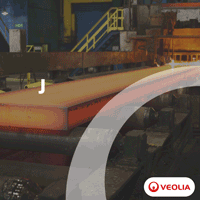United States Steel Corporation Reports 2015 First Quarter Results
05/01/2015 - -- Net loss of $75 million, or $0.52 per diluted share; Adjusted net loss of $10 million, or $0.07 per diluted share -- Adjusted EBITDA of $110 million -- Operating cash flow of $136 million -- Total liquidity of $2.8 billion, including $1.3 billion of cash -- Updated full-year 2015 outlook to adjusted EBIT of $115 million to $315 million and adjusted EBITDA of $700 million to $900 million
Commenting on results, U. S. Steel President and Chief Executive Officer Mario Longhi said, "Our results reflect extremely challenging market conditions, including the negative impact of the tremendously high levels of imports, which have contributed to reduced volumes and average realized prices. We have taken aggressive action to balance our operational footprint in the most cost effective way; however, we are maintaining our customer focus and our flexibility to respond quickly when market conditions improve. We have accelerated our Carnegie Way transformation efforts and we expect we will continue to increase our earnings power and create stockholder value, while working to minimize the negative impact on our business arising from current market conditions."
Segment loss before interest and income taxes was $21 million, or $5 per ton, for the first quarter of 2015 compared to segment earnings before interest and income taxes (EBIT) of $420 million, or $92 per ton, in the fourth quarter of 2014 and segment EBIT of $154 million, or $30 per ton, in the first quarter of 2014.
For the first quarter 2015, we recorded a tax benefit of $174 million on our pre-tax loss of $249 million. The tax provision reflects a benefit for percentage depletion in excess of cost depletion for iron ore that we produce and consume or sell.
Despite the challenging market conditions, we maintained positive operating cash flow of $136 million for the quarter ended March 31, 2015. As of March 31, U. S. Steel had $1.3 billion of cash and $2.8 billion of total liquidity compared to cash and total liquidity of $1.4 billion and $3.1 billion, respectively, at December 31, 2014.
Segment Analysis
First quarter results for our Flat-Rolled segment decreased significantly compared to the fourth quarter due to both lower shipments, including intersegment shipments to our Tubular segment, and average realized prices. Our Flat-Rolled segment results continue to be adversely impacted by the massive volume of steel imports that accelerated during the first quarter, many of which we believe are unfairly traded. Average realized prices decreased due to the adverse effect of these imports, which have served to dramatically reduce spot market prices and indices and have negatively impacted revenue streams in both spot and certain contract volumes. As a result, we have aggressively adjusted our operating footprint. The decline in results also reflects operating inefficiencies due to reduced production levels. These decreases have been partially offset by benefits provided by our Carnegie Way efforts.
European segment results were comparable to the fourth quarter. The positive effects of an increase in shipments, a reduction in raw materials costs, and benefits provided by our Carnegie Way efforts were offset by negative foreign currency effects and a slight decrease in average realized euro-based prices.
First quarter results for our Tubular segment decreased significantly compared to the fourth quarter primarily due to lower shipments. Shipments were adversely impacted by reduced drilling activity caused by low crude oil prices and the significant amount of steel and tubular imports, many of which we believe are unfairly traded. The decrease in results is also attributable to operating inefficiencies as a result of reduced production levels. These decreases have been partially offset by benefits provided by our Carnegie Way efforts.
2015 Outlook
Commenting on U. S. Steel's outlook for 2015, Longhi said, "We are currently operating in the face of extremely difficult conditions, particularly in North America. We have made significant progress during our Carnegie Way transformation on improving our business model, including cost structure improvements, which will enable us to increase our earnings power across all market conditions."
The headwinds we faced entering 2015 have intensified. Spot prices for flat-rolled products have decreased at an accelerated pace reaching levels well below market expectations at the beginning of the year and imports have remained at historically high levels, both negatively impacting our flat-rolled order rates. The pace and magnitude of the drop in both oil prices and drilling rig counts have resulted in decreased steel demand for both finished tubular products and substrate supplied by our Flat-Rolled segment for the production of tubular products. Lower order rates for both flat-rolled and tubular products have resulted in lower utilization rates and increased operational inefficiencies at all of our U.S. facilities.
We expect lower overall steel consumption levels to unfavorably impact the timing of a rebalance of supply chain inventory levels in both the flat-rolled and tubular markets we serve; however, we expect market conditions to improve during the second half of 2015, which will have a positive impact on our Flat-Rolled segment as inventory destocking nears completion. We have taken aggressive actions to reduce costs and adjust our operating levels in the near term but cannot fully offset these increased headwinds. We remain focused on meeting both the current and future needs of our customers by providing innovative and value enhancing solutions, as well as on the Carnegie Way transformation.
Based on all of the factors described above, we expect full-year 2015 adjusted EBIT to be between $115 million and $315 million, or full-year 2015 adjusted earnings before interest, income taxes, depreciation and amortization (EBITDA) of between $700 million and $900 million.
For the full report, visit www.ussteel.com.



-(220-x-200-px)-(130-x-130-px)-(220-x-200-px).jpg?lang=en-US&ext=.jpg)
.gif?width=200&height=200&mediaprotectionhash=ddb07947ad3b4ab959a83714461eccd5c6895f370695eb035a9ff7aa736f8ad9&ext=.gif)





